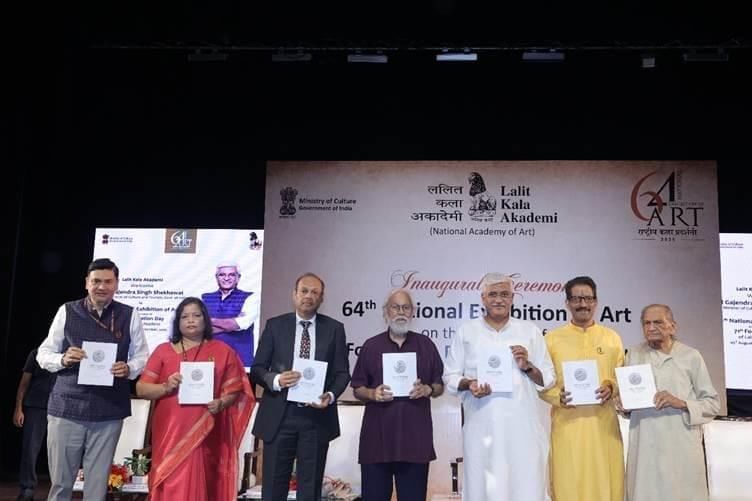UPSC Daily Current Affairs: 7th August 2025 | Current Affairs & Hindu Analysis: Daily, Weekly & Monthly PDF Download
GS1/History & Culture
Lalit Kala Akademi and the 64th National Exhibition of Art
 Why in News?
Why in News?
The 64th National Exhibition of Art (NEA), organized by the Lalit Kala Akademi, India’s National Academy of Art, was inaugurated in New Delhi. This exhibition is a significant event in the field of Indian art, showcasing a variety of artistic expressions and promoting cultural heritage.
Key Takeaways
- The 64th NEA is being held from 5 August to 15 September at Kamani Auditorium and Lalit Kala Art Galleries, New Delhi.
- Lalit Kala Akademi was established on 5 August 1954 and is recognized as an autonomous organization.
Additional Details
- Establishment: Lalit Kala Akademi was inaugurated by Maulana Abul Kalam Azad, the then Minister for Education.
- Legal Status: The Akademi received statutory status in 1957 under the Societies Registration Act of 1860.
- Funding: It is funded by the Ministry of Culture, Government of India.
- Structure: Operates through a General Council, Executive Board, and various Committees with regional centres in Chennai, Kolkata, Lucknow, Bhubaneswar, and Garhi (New Delhi).
- Functions: The Akademi promotes modern, contemporary, folk, and tribal visual arts of India and maintains a permanent art collection.
- International Role: Facilitates cultural exchange through international agreements.
- Key Events: Annual flagship event showcasing artists since 1955, and notable exhibitions like Triennale India and Print Biennale India.
The NEA serves as a platform for both emerging and established artists, reinforcing India's cultural diplomacy and enhancing its soft power on a global scale.
GS3/Economy
India’s Herbicide Revolution
Why in News?
The use of crop protection chemicals, commonly known as pesticides, plays a crucial role in agriculture by protecting crops from pests that can cause direct damage or spread diseases. For example, the white-backed plant hopper significantly affects rice crops by both feeding on them and transmitting the Fiji virus, leading to stunted growth, an issue currently impacting farmers in Punjab and Haryana.
Key Takeaways
- Herbicides are experiencing the fastest growth in India’s crop protection market.
- Labour shortages are leading to increased reliance on herbicides.
- There is a shift towards preventive herbicide use among farmers.
- Multinational corporations dominate the herbicide market, but Indian firms are beginning to innovate.
Additional Details
- Market Growth: India’s organised crop protection chemicals market is valued at approximately ₹24,500 crore, with herbicides growing at an annual rate of over 10%, totaling around ₹8,200 crore.
- Labour Shortages: The agricultural sector is facing severe labour shortages, with wages rising from ₹326.2 in 2019 to ₹447.6 in 2024, prompting farmers to increasingly adopt herbicides as labour-saving tools.
- Shifts in Strategy: Farmers are moving towards preventive herbicide strategies, utilizing pre-emergent and early post-emergent herbicides to manage weed growth proactively.
- Innovation: Indian companies like Crystal Crop Protection Ltd (CCPL) are developing new products, such as the Sikosa herbicide, which combines two active ingredients for effective weed control at competitive prices.
In summary, India is undergoing a significant transformation in its agricultural practices, particularly in the herbicide segment, which is responding to labour scarcity and evolving farming methods. The growing emphasis on preventive measures and the push for innovation among Indian firms indicate a promising future for the country's herbicide market, though challenges remain in competing with multinational giants.
GS3/Environment
Indian Flapshell Turtle
Why in News?
A rare sighting of an albino Indian flapshell turtle, distinguished by its vibrant yellow shell and skin, was recently reported in a freshwater lake located in Chikodra village, Gujarat.
Key Takeaways
- The Indian flapshell turtle is a freshwater species primarily found in tropical South Asian countries.
- It is classified as Vulnerable on the IUCN Red List and is protected under several conservation laws.
Additional Details
- Scientific Name: Lissemys punctata
- Distribution: This species is mainly found in Pakistan, India, Sri Lanka, Nepal, Bangladesh, and Myanmar.
- Habitat: They inhabit shallow, quiet, often stagnant waters such as rivers, streams, marshes, ponds, lakes, and irrigation canals. These turtles prefer environments with sand or mud bottoms for their burrowing tendencies.
- Physical Features: The Indian flapshell turtle is identifiable by femoral flaps that cover its limbs when retracted into its shell. Its oval, soft shell indicates an evolutionary link to hard-shelled turtles.
- Size and Lifespan: They can reach lengths of up to 370 mm and typically live for around 20 years.
- Diet: These turtles are omnivores and are generally solitary. They are active during the day and show remarkable adaptability, capable of surviving extreme droughts for about 120-160 days.
- Conservation Status:
- IUCN Red List: Vulnerable
- CITES: Appendix I
- Wildlife (Protection) Act, 1972: Schedule I
Albinism, the condition observed in the turtle, is a rare genetic anomaly that affects melanin production, resulting in a lack of pigmentation in hair, skin, and eyes across various species including mammals, birds, reptiles, amphibians, and fish. This trait is a recessive mutation, occurring in approximately one out of every 10,000 births, necessitating both parents to carry the gene for an offspring to exhibit albinism. Some animals may show partial albinism, known as leucism, characterized by white fur or skin but typically with normal eye pigmentation.
The recent sighting of the albino Indian flapshell turtle not only highlights the uniqueness of this species but also underscores the importance of conservation efforts in protecting vulnerable wildlife.
GS2/International Relations
Intermediate-Range Nuclear Forces (INF) Treaty
 Why in News?
Why in News?
Russia has officially declared its withdrawal from the 1987 Intermediate-Range Nuclear Forces (INF) Treaty. This decision signifies a crucial shift in the landscape of Cold War-era nuclear arms control.
Key Takeaways
- The INF Treaty was signed in 1987 by U.S. President Ronald Reagan and Soviet leader Mikhail Gorbachev.
- The treaty prohibited ground-launched ballistic and cruise missiles with ranges from 500 to 5,500 kilometers.
- Its implementation resulted in the elimination of 2,692 missiles by June 1, 1991.
Additional Details
- Verification: The treaty allowed for on-site inspections, which set a precedent for future arms control agreements.
- Scope: It included both nuclear and conventional missile systems, becoming a cornerstone of post-Cold War strategic stability.
- Reasons for Russia's Exit: Russia cited U.S. military deployments, such as Tomahawk launchers in the Philippines and Dark Eagle hypersonic missiles in Australia, as key factors for its withdrawal. Additionally, escalating U.S. submarine deployments in 2025 and increasing NATO tensions contributed to this decision.
- Russia previously withdrew from the New START Treaty and the Comprehensive Nuclear-Test-Ban Treaty (CTBT) in 2023.
Implications
- Collapse of Arms Control: This exit eliminates a crucial framework for nuclear restraint.
- Resurgence of Arms Race: There is a potential for renewed missile deployments in Europe and the Asia-Pacific region.
- Regional Threats: Countries in NATO and East Asia may face heightened vulnerabilities.
- Proliferation Risk: The situation may encourage other nations, such as China and India, to enhance their military capabilities.
In summary, the withdrawal from the INF Treaty marks a significant moment in international relations, with potential consequences for global security and arms control frameworks.
GS3/Environment
District Flood Severity Index
Why in News?
Researchers from IIT Delhi and IIT Gandhinagar have developed a District Flood Severity Index (DFSI) to assess the impact of floods across various districts in India. This new index evaluates historical flood severity based on factors such as the number of people affected, the extent and duration of flooding, and the overall impact on local populations.
Key Takeaways
- The District Flood Severity Index accounts for the historical severity of floods in India.
- Parameters include the mean duration of flooding events, percentage of area historically flooded, total deaths, injuries, and district population.
- Developed using the India Flood Inventory with Impacts (IFI-Impacts) database.
- Identifying flood severity at the district level aids in effective flood management and planning.
Additional Details
- Parameters Used:The index incorporates several critical factors:
- Mean duration of flooding events in days.
- Percentage of the area historically affected by floods.
- Total number of deaths and injuries due to flooding.
- Population of the district.
- Key Findings:
- Patna ranks as the highest on the index, indicating significant historical flood impacts.
- Thiruvananthapuram, while having a high number of flooding events, does not appear in the top 30 districts for flood severity.
- Assam's Dhemaji, Kamrup, and Nagaon districts have experienced over 178 flooding events, averaging more than three events per year.
- Urban Flooding Factors: Urban flooding is attributed to both hydrometeorological reasons and poor urban planning.
The District Flood Severity Index is a crucial tool for understanding flood impacts at the district level, facilitating better management strategies and preparedness for future flooding events.
GS2/Governance
Yashoda AI Initiative
Why in News?
The Minister of State for Women and Child Development recently informed the Rajya Sabha about the launch of the Yashoda AI initiative, an AI literacy program aimed at empowering women across the country.
Key Takeaways
- Yashoda AI is set to commence in May 2025.
- The program aims to enhance digital inclusion and AI literacy among women.
- It is initiated by the National Commission for Women (NCW) in partnership with Future Shift Labs (FSL).
- Approximately 2500 women from rural and semi-urban areas have already received training.
Additional Details
- Objective: The main goal of Yashoda AI is to equip women with knowledge in AI, focusing on cyber security, digital privacy, and safe online practices.
- Target Audience: The program specifically targets women from rural and semi-urban regions, including members of Self-Help Groups (SHGs) and local elected representatives such as Sarpanchs, Pradhans, Parshads, Mayors, MLAs, and ASHA workers.
- Discussion Topics: The initiative will include discussions on critical issues related to AI, such as AI-driven crimes and practical safety strategies.
This initiative not only aims to provide essential skills but also seeks to promote awareness regarding digital safety and privacy among women, contributing to their empowerment in the digital age.
GS3/Environment
Bacterial Cause Behind Mass Starfish Deaths
 Why in News?
Why in News?
Since 2013, an alarming phenomenon has occurred along North America's Pacific coast, where over 5 billion starfish have died due to a wasting disease. This disease has now been linked to Vibrio pectenicida, a bacterium related to cholera.
Key Takeaways
- Over 5 billion starfish deaths recorded since 2013.
- Vibrio pectenicida identified as the causal agent of the disease.
- Major impact on the sunflower sea star population, which declined by 90%.
Additional Details
- About Starfish (Sea Stars):
- Taxonomy: Belong to the phylum Echinodermata; exclusively marine organisms.
- Species include: Brisingida, Forcipulatida, Velatida, Valvatida, and Spinuloside.
- Body Structure:
- Exhibits radial symmetry in adults and bilateral symmetry in larvae.
- Has a calcareous exoskeleton for protection.
- Features a water vascular system for respiration and circulation.
- Unique Features:
- Regeneration of lost limbs.
- Lack of blood or brain; nutrients circulated via seawater.
- Eyespots at arm tips to sense light.
- Tough skin made of calcium carbonate.
- Feeding Habits: Starfish can be carnivorous, detritivorous, or scavengers.
- Ecological Consequences:
- Starfish are keystone predators, especially of sea urchins.
- Their decline has led to increased sea urchin populations, causing overgrazing of kelp forests.
- This has resulted in biodiversity loss and reduced carbon sequestration.
This situation highlights the complex interdependencies in marine ecosystems, where the decline of a single species can lead to significant ecological consequences.
GS3/Economy
RBI’s Monetary Policy Review - Balancing Growth Optimism with Inflationary Caution
Why in News?
This article discusses the outcomes of the Reserve Bank of India's (RBI) recent Monetary Policy Committee (MPC) meeting, focusing on its evaluation of inflation trends, GDP growth forecasts, external trade risks, and the anticipated policy direction.
Key Takeaways
- The RBI maintained the repo rate at its current level, adopting a neutral stance.
- Inflation is projected to see an upward trend, with CPI inflation expected to exceed 4% in 2026.
- The RBI has already implemented a total policy rate reduction of 100 basis points since February 2025.
Additional Details
- Inflation Outlook: CPI inflation dropped to around 2% in June 2025 and is projected to rise to 2.5% for the following quarters. The FY26 CPI inflation forecast has been revised down to 3.1% due to statistical effects and vegetable price deflation.
- Vegetable Price Volatility: Following a high inflation rate of 27% in 2024, vegetable price deflation has occurred, averaging -15% recently. The sub-index for vegetables (6% weight in CPI) remains very volatile, with CPI inflation (excluding vegetables) stable between 3-4% during FY25 and Q1 FY26.
- Future Projections: An anticipated reversal of the base effect may cause CPI inflation to surpass 4% in Q4 FY26, with FY27 CPI inflation potentially averaging above 4.5%.
- GDP Outlook: The RBI has retained its GDP growth projection for FY26 at 6.5%, citing factors like interest rate cuts and strong agricultural output.
- Consumption and Employment Concerns: Urban consumption is sluggish due to low income growth and a slowdown in hiring, particularly within the IT sector, where top firms are experiencing stagnant employment.
- Investment Trends: Public capital expenditure saw a significant increase of 52% in Q1 FY26, although private sector investment remains cautious due to economic uncertainties.
- External Risks: Challenges such as US reciprocal tariffs pose risks to India's external sector, with merchandise exports expected to contract while services exports remain strong.
- Current Account and Forex Reserves: India’s current account deficit is manageable at 0.9% of GDP in FY26, with forex reserves comfortably at $689 billion, covering 11 months of imports.
- Policy Outlook: With low real interest rates (around 1%) and ample liquidity, the RBI is likely to pause further rate cuts unless there is a significant downturn due to external shocks.
The RBI’s cautious yet optimistic approach showcases its understanding of the dynamic macroeconomic environment. Ensuring sustained domestic demand, strategic policy adjustments, and vigilance against inflation and external risks are essential for maintaining economic stability in FY26 and beyond.
GS2/International Relations
Decoding China, the Lessons for a Vulnerable India
Why in News?
The recent recall of over 300 Chinese engineers from Foxconn’s iPhone 17 manufacturing facilities in Tamil Nadu and Karnataka is not merely a corporate decision. It signifies a deeper geoeconomic strategy by China aimed at limiting India's potential as a global manufacturing power. This incident highlights China's strategic anxiety over India's rise and necessitates a critical analysis of the motivations and implications behind such actions.
Key Takeaways
- The withdrawal of skilled Chinese engineers is a strategic move to hinder India's manufacturing growth.
- China's actions reflect its broader strategy to maintain manufacturing dominance amid rising competition from India.
- India faces structural challenges in its manufacturing sector and must address these to become a credible competitor.
Additional Details
- China's Strategic Withdrawal: The departure of these engineers has stifled the transfer of crucial technical knowledge essential for India's industrial growth, particularly in high-tech production.
- Export Restrictions: China has implemented informal barriers on exports of rare earth elements crucial for electronics, which disrupts India’s supply chains and raises costs.
- India's Manufacturing Challenges: Despite its ambitions, India’s manufacturing sector is underdeveloped, reliant on imports for essential components like chips and semiconductors.
- Infrastructure Issues: Bureaucratic hurdles and infrastructure gaps hinder India's ability to advance as a manufacturing hub.
- China's Economic Statecraft: China employs economic tactics to suppress competition, utilizing its overcapacity to dominate global markets.
The withdrawal of Chinese engineers from Foxconn symbolizes the intricate dynamics at play in Asia's industrial landscape. For India to compete effectively, it must focus on enhancing its infrastructure, reducing regulatory barriers, and fostering indigenous technological capabilities. The time has come for India to shift from mere aspirations to actionable strategies that build a self-reliant industrial base. The responsibility lies with India to shape its own economic destiny.
GS3/Environment
Teak Defoliator Moth and Its Biocontrol Solution
 Why in News?
Why in News?
The Kerala Forest Research Institute has successfully identified and mass-produced the Hyblaea puera Nucleopolyhedrosis Virus (HpNPV), providing an eco-friendly alternative to chemical pesticides. This innovative approach aims to prevent extensive defoliation of teak trees caused by the teak defoliator moth (Hyblaea puera).
Key Takeaways
- Hyblaea puera is a significant pest that severely affects teak trees and mangroves.
- The HpNPV virus offers a promising biocontrol method to combat this pest.
- Annual outbreaks of the moth lead to considerable economic losses in timber production.
Additional Details
- About Teak Defoliator Moth: This moth is a cryptic species recognized as a major pest of teak trees, impacting their growth and health.
- Impact on Teak Trees: The larvae of the moth initiate damage with the arrival of monsoon rains, leading to energy diversion from growth to leaf regeneration.
- Nature of Damage: The moths devour the leaves, often leaving only the midrib intact, significantly affecting the tree's health.
- Geographical Distribution: Native to South Asia and Southeast Asia, it is found in forests from India to Australia.
- Economic Impact: The teak defoliator causes substantial economic losses during its seasonal outbreaks, affecting timber production.
- Hyblaea puera Nucleopolyhedrosis Virus (HpNPV): This virus is recognized as a potential biocontrol agent that can cause lethal infections in pest larvae, preventing widespread defoliation. It can multiply extensively inside a single larva, releasing vast amounts of inoculum upon death.
The development of HpNPV represents a significant advancement in sustainable pest management, offering an effective solution to protect teak plantations from the destructive impacts of the teak defoliator moth.
GS2/Polity
Legal Insanity and Its Implications in Judicial Proceedings
Why in News?
The Chhattisgarh High Court recently acquitted a man of double murder on the grounds of legal insanity, underscoring the critical role of mental state evaluations in criminal trials.
Key Takeaways
- Legal insanity is a defense in criminal law based on mental incapacity.
- The accused must prove that they were unable to understand the nature of their actions due to severe mental illness.
- There are various types of legal insanity, including emotional and temporary insanity.
Additional Details
- Legal Insanity: This term refers to a mental state severe enough to negate legal responsibility for a crime. It assumes that the defendant could not appreciate the nature of their actions or differentiate right from wrong at the time of the offense.
- The insanity defense is a legal concept and not merely a clinical one; proving insanity requires more than just having a mental disorder.
- To successfully claim legal insanity, the accused must provide evidence, often through psychiatric evaluations, showing they were not in control of their reasoning faculties during the incident.
- Different forms of legal insanity include emotional insanity, characterized by intense emotional disturbance, and temporary insanity, which exists solely at the time of the crime.
- The Supreme Court case of Surendra Mishra vs. State of Jharkhand (AIR 2011 SC 627) established that not all individuals with mental illnesses are exempt from criminal liability; the burden of proof lies with the accused.
In conclusion, the concept of legal insanity plays a crucial role in ensuring that individuals who are genuinely unable to comprehend their actions due to mental health issues are treated fairly within the legal system. This highlights the importance of mental health evaluations in understanding criminal responsibility.
|
49 videos|5376 docs|1137 tests
|
FAQs on UPSC Daily Current Affairs: 7th August 2025 - Current Affairs & Hindu Analysis: Daily, Weekly & Monthly
| 1. What is the significance of the Lalit Kala Akademi in promoting Indian art? |  |
| 2. What are the key features of the 64th National Exhibition of Art? |  |
| 3. How has India's herbicide revolution impacted agricultural practices? |  |
| 4. What is the status of the Indian Flapshell Turtle and its conservation efforts? |  |
| 5. What are the implications of the Intermediate-Range Nuclear Forces (INF) Treaty for global security? |  |





















